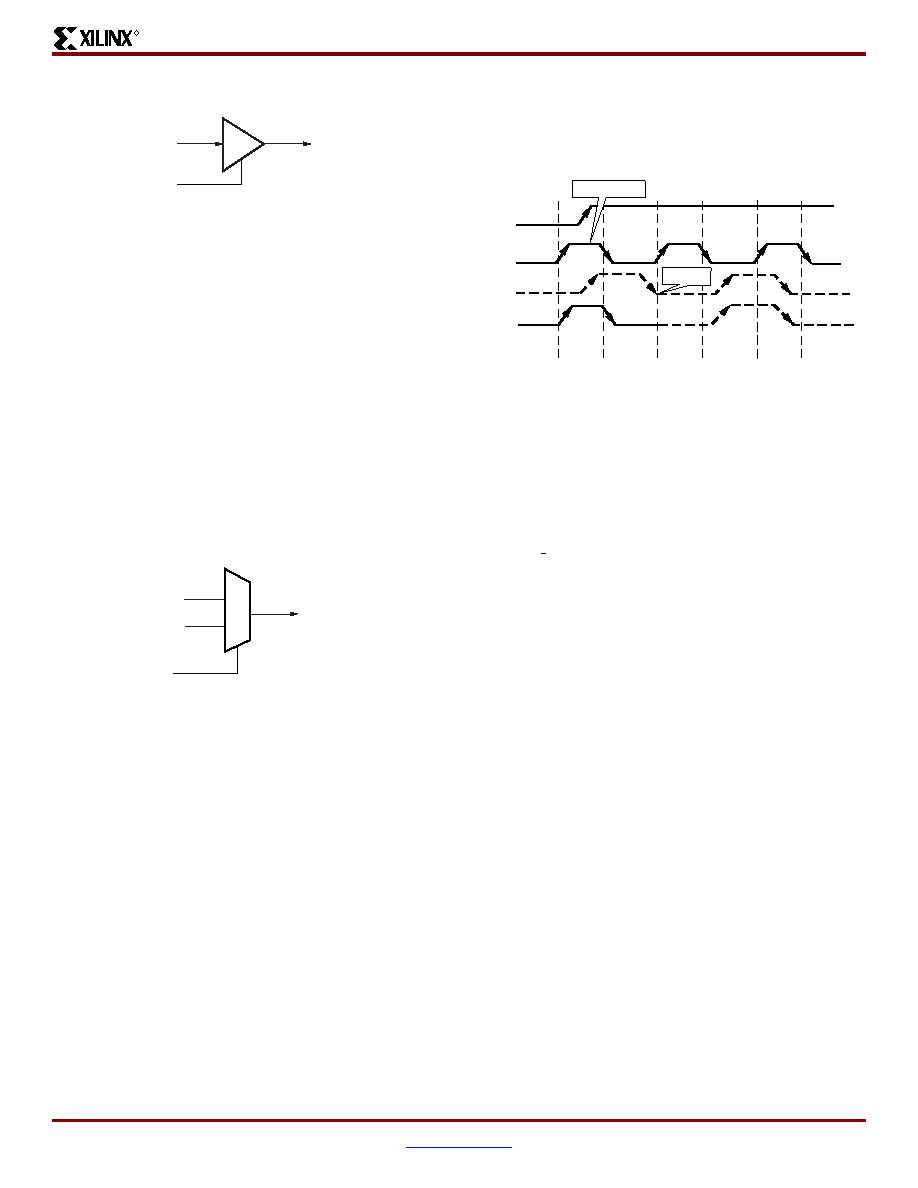- 您現(xiàn)在的位置:買賣IC網(wǎng) > PDF目錄4200 > XC2V6000-4FFG1517C (Xilinx Inc)IC FPGA VIRTEX-II 6M 1517-FBGA PDF資料下載
參數(shù)資料
| 型號: | XC2V6000-4FFG1517C |
| 廠商: | Xilinx Inc |
| 文件頁數(shù): | 250/318頁 |
| 文件大?。?/td> | 0K |
| 描述: | IC FPGA VIRTEX-II 6M 1517-FBGA |
| 產(chǎn)品變化通告: | FPGA Family Discontinuation 18/Apr/2011 |
| 標(biāo)準(zhǔn)包裝: | 1 |
| 系列: | Virtex®-II |
| LAB/CLB數(shù): | 8448 |
| RAM 位總計: | 2654208 |
| 輸入/輸出數(shù): | 1104 |
| 門數(shù): | 6000000 |
| 電源電壓: | 1.425 V ~ 1.575 V |
| 安裝類型: | 表面貼裝 |
| 工作溫度: | 0°C ~ 85°C |
| 封裝/外殼: | 1517-BBGA,F(xiàn)CBGA |
| 供應(yīng)商設(shè)備封裝: | 1517-FCBGA(40x40) |
第1頁第2頁第3頁第4頁第5頁第6頁第7頁第8頁第9頁第10頁第11頁第12頁第13頁第14頁第15頁第16頁第17頁第18頁第19頁第20頁第21頁第22頁第23頁第24頁第25頁第26頁第27頁第28頁第29頁第30頁第31頁第32頁第33頁第34頁第35頁第36頁第37頁第38頁第39頁第40頁第41頁第42頁第43頁第44頁第45頁第46頁第47頁第48頁第49頁第50頁第51頁第52頁第53頁第54頁第55頁第56頁第57頁第58頁第59頁第60頁第61頁第62頁第63頁第64頁第65頁第66頁第67頁第68頁第69頁第70頁第71頁第72頁第73頁第74頁第75頁第76頁第77頁第78頁第79頁第80頁第81頁第82頁第83頁第84頁第85頁第86頁第87頁第88頁第89頁第90頁第91頁第92頁第93頁第94頁第95頁第96頁第97頁第98頁第99頁第100頁第101頁第102頁第103頁第104頁第105頁第106頁第107頁第108頁第109頁第110頁第111頁第112頁第113頁第114頁第115頁第116頁第117頁第118頁第119頁第120頁第121頁第122頁第123頁第124頁第125頁第126頁第127頁第128頁第129頁第130頁第131頁第132頁第133頁第134頁第135頁第136頁第137頁第138頁第139頁第140頁第141頁第142頁第143頁第144頁第145頁第146頁第147頁第148頁第149頁第150頁第151頁第152頁第153頁第154頁第155頁第156頁第157頁第158頁第159頁第160頁第161頁第162頁第163頁第164頁第165頁第166頁第167頁第168頁第169頁第170頁第171頁第172頁第173頁第174頁第175頁第176頁第177頁第178頁第179頁第180頁第181頁第182頁第183頁第184頁第185頁第186頁第187頁第188頁第189頁第190頁第191頁第192頁第193頁第194頁第195頁第196頁第197頁第198頁第199頁第200頁第201頁第202頁第203頁第204頁第205頁第206頁第207頁第208頁第209頁第210頁第211頁第212頁第213頁第214頁第215頁第216頁第217頁第218頁第219頁第220頁第221頁第222頁第223頁第224頁第225頁第226頁第227頁第228頁第229頁第230頁第231頁第232頁第233頁第234頁第235頁第236頁第237頁第238頁第239頁第240頁第241頁第242頁第243頁第244頁第245頁第246頁第247頁第248頁第249頁當(dāng)前第250頁第251頁第252頁第253頁第254頁第255頁第256頁第257頁第258頁第259頁第260頁第261頁第262頁第263頁第264頁第265頁第266頁第267頁第268頁第269頁第270頁第271頁第272頁第273頁第274頁第275頁第276頁第277頁第278頁第279頁第280頁第281頁第282頁第283頁第284頁第285頁第286頁第287頁第288頁第289頁第290頁第291頁第292頁第293頁第294頁第295頁第296頁第297頁第298頁第299頁第300頁第301頁第302頁第303頁第304頁第305頁第306頁第307頁第308頁第309頁第310頁第311頁第312頁第313頁第314頁第315頁第316頁第317頁第318頁

Virtex-II Platform FPGAs: Functional Description
R
DS031-2 (v3.5) November 5, 2007
Module 2 of 4
Product Specification
29
If the CE input is inactive (Low) prior to the incoming rising
clock edge, the following clock pulse does not pass through
the clock buffer, and the output stays Low. Any level change
of CE during the incoming clock High time has no effect. CE
must not change during a short setup window just prior to
the rising clock edge on the BUFGCE input I. Violating this
setup time requirement can result in an undefined runt
pulse output.
BUFGMUX
BUFGMUX can switch between two unrelated, even asyn-
chronous clocks. Basically, a Low on S selects the I0 input,
a High on S selects the I1 input. Switching from one clock to
the other is done in such a way that the output High and Low
time is never shorter than the shortest High or Low time of
either input clock. As long as the presently selected clock is
High, any level change of S has no effect .
If the presently selected clock is Low while S changes, or if
it goes Low after S has changed, the output is kept Low until
the other ("to-be-selected") clock has made a transition
from High to Low. At that instant, the new clock starts driv-
ing the output.
The two clock inputs can be asynchronous with regard to
each other, and the S input can change at any time, except
for a short setup time prior to the rising edge of the presently
selected clock (I0 or I1). Violating this setup time require-
ment can result in an undefined runt pulse output.
All Virtex-II devices have 16 global clock multiplexer buffers.
Figure 44 shows a switchover from I0 to I1.
The current clock is CLK0.
S is activated High.
If CLK0 is currently High, the multiplexer waits for CLK0
to go Low.
Once CLK0 is Low, the multiplexer output stays Low
until CLK1 transitions High to Low.
When CLK1 transitions from High to Low, the output
switches to CLK1.
No glitches or short pulses can appear on the output.
Local Clocking
In addition to global clocks, there are local clock resources
in the Virtex-II devices. There are more than 72 local clocks
in the Virtex-II family. These resources can be used for
many different applications, including but not limited to
memory interfaces. For example, even using only the left
and right I/O banks, Virtex-II FPGAs can support up to 50
local clocks for DDR SDRAM. These interfaces can operate
beyond 200 MHz on Virtex-II devices.
Digital Clock Manager (DCM)
The Virtex-II DCM offers a wide range of powerful clock
management features.
Clock De-skew: The DCM generates new system
clocks (either internally or externally to the FPGA),
which are phase-aligned to the input clock, thus
eliminating clock distribution delays.
Frequency Synthesis: The DCM generates a wide
range of output clock frequencies, performing very
flexible clock multiplication and division.
Phase Shifting: The DCM provides both coarse phase
shifting and fine-grained phase shifting with dynamic
phase shift control.
The DCM utilizes fully digital delay lines allowing robust
high-precision control of clock phase and frequency. It also
utilizes fully digital feedback systems, operating dynamically
to compensate for temperature and voltage variations dur-
ing operation.
Up to four of the nine DCM clock outputs can drive inputs to
global clock buffers or global clock multiplexer buffers simul-
taneously (see Figure 45). All DCM clock outputs can simul-
taneously drive general routing resources, including routes
to output buffers.
Figure 42: Virtex-II BUFGCE Function
Figure 43: Virtex-II BUFGMUX Function
O
I
CE
BUFGCE
DS031_62_101200
O
I0
I1
S
BUFGMUX
DS031_63_112900
Figure 44: Clock Multiplexer Waveform Diagram
S
I0
I1
OUT
Wait for Low
Switch
DS031_46_020604
相關(guān)PDF資料 |
PDF描述 |
|---|---|
| XC2V6000-4FFG1152C | IC VIRTEX-II FPGA 6M 1152-FCBGA |
| XC2V6000-4BF957C | IC FPGA VIRTEX II 3M 957-FCBGA |
| AMC28DRAI-S734 | CONN EDGECARD 56POS .100 R/A PCB |
| XC6VHX250T-1FFG1154I | IC FPGA VIRTEX 6 251K 1156FCBGA |
| FMC17DREI | CONN EDGECARD 34POS .100 EYELET |
相關(guān)代理商/技術(shù)參數(shù) |
參數(shù)描述 |
|---|---|
| XC2V6000-4FFG1517I | 功能描述:IC FPGA VIRTEX-II 6M 1517-FBGA RoHS:是 類別:集成電路 (IC) >> 嵌入式 - FPGA(現(xiàn)場可編程門陣列) 系列:Virtex®-II 產(chǎn)品變化通告:XC4000(E,L) Discontinuation 01/April/2002 標(biāo)準(zhǔn)包裝:24 系列:XC4000E/X LAB/CLB數(shù):100 邏輯元件/單元數(shù):238 RAM 位總計:3200 輸入/輸出數(shù):80 門數(shù):3000 電源電壓:4.5 V ~ 5.5 V 安裝類型:表面貼裝 工作溫度:-40°C ~ 100°C 封裝/外殼:120-BCBGA 供應(yīng)商設(shè)備封裝:120-CPGA(34.55x34.55) |
| XC2V6000-4FG256C | 制造商:XILINX 制造商全稱:XILINX 功能描述:Virtex-II Platform FPGAs: Complete Data Sheet |
| XC2V6000-4FG256I | 制造商:XILINX 制造商全稱:XILINX 功能描述:Virtex-II Platform FPGAs: Complete Data Sheet |
| XC2V6000-4FG456C | 制造商:XILINX 制造商全稱:XILINX 功能描述:Virtex-II Platform FPGAs: Complete Data Sheet |
| XC2V6000-4FG456I | 制造商:XILINX 制造商全稱:XILINX 功能描述:Virtex-II Platform FPGAs: Complete Data Sheet |
發(fā)布緊急采購,3分鐘左右您將得到回復(fù)。